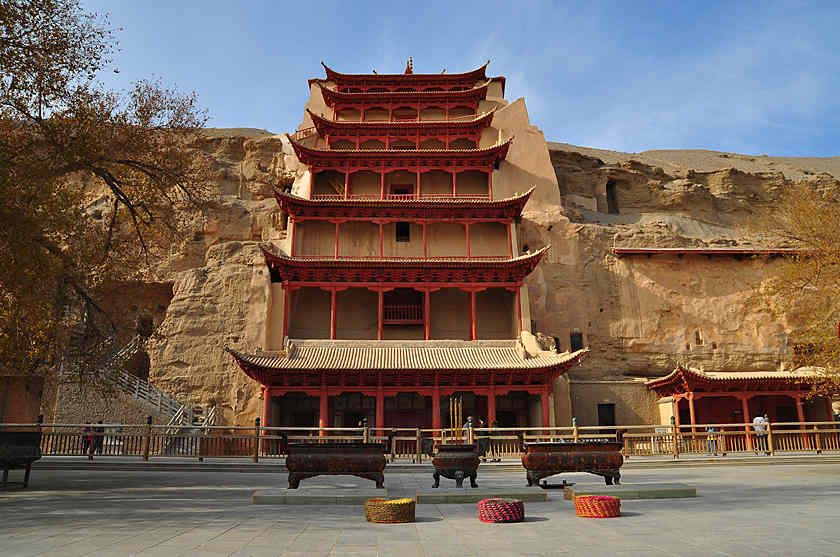Chinese Name: 莫高窟 Pronunciation: mò gāo kū
Suggested Visiting Hours: 3-4 Hours
Building Area: The total length is about 1600 meters
Building Time: 366 AD
Best Visiting Season: Summer and Autumn
Address: 217 Provincial Road, Dunhuang, Gansu Province, China.
|
Tickets
|
Peak Season
(April 1st - November 30th)
|
Low Season
(December 1st - March 31st)
|
|
| Type A Joint Ticket (Including the admission fee of visiting 8 open caves, Mogao Grottoes Digital Exhibition Center, return Mogao Grottoes transportation) |
238 yuan | TBC | |
| Type B Joint Ticket (Including the admission fee of visiting 4 open caves, return Mogao Grottoes transportation) |
100 yuan | TBC | |
| Type C Joint Ticket (Watching the themed digital movie "Millennium Mogao Grottoes" and the dome movie "Dream Buddha Palace") |
50 yuan | TBC | |
|
Park Gate
|
Peak Season
(April 1st to November 30th) |
Low Season
(December 1st to March 31st) |
|
| Opening Hours | 8:00-18:00 | 9:00-17:30 | |
| Online Ticket Office Opening Hours | 7:00-22:00 | 7:00-22:00 | |
| Closing Time | 18:00 | 17:30 | |
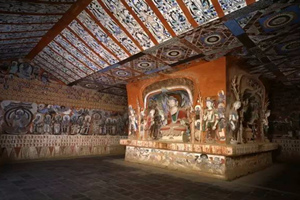
Mogao Grottoes, commonly known as Thousand Buddha Caves, is located in Dunhuang at the western end of the Hexi Corridor. It was built in the pre-Qin period of the Sixteen Kingdoms, and has undergone the construction of the Northern Dynasties, Sui, Tang, Five Dynasties, Xixia, Yuan and other dynasties. It has formed a huge scale, with 735 caves, 45,000 square meters of murals and 2415 clay sculptures, which is the largest and most abundant Buddhist art site in the world.
Mogao Grottoes is a large grotto temple that integrates painting, sculpture and architectural art, with murals as the mainstay and statues as the supplement. Its grottoes mainly include Zen caves, central tower caves, temple caves, central Buddhist altar caves, big statue caves, and Nirvana caves. The size of the caves varies greatly, the largest cave 16 is 268 square meters. The original wooden temples outside the cave are connected by corridors and plank roads, but most of them no longer exist.
There are 735 caves from the Northern Wei Dynasty to the Yuan Dynasty at the Mogao Grottoes, which are divided into northern and southern areas. The southern area is the main body of the Mogao Grottoes. It is a place for monks to engage in religious activities.
There are 487 caves with murals or statues. And 248 caves in the North District, of which only 5 have murals or statues. The others are places where monks practice, live, and bury them after death. There are a total of 492 caves in the two districts with murals and statues, including 45,000 square meters of murals, 2,415 clay sculptures, 5 wooden cliffs in the Tang and Song Dynasties, and thousands of lotus pillars and floor tiles.
From the perspective of the categories of Chinese painting and art, the figure paintings, landscape paintings, animal paintings, and decorative pattern paintings in the Dunhuang Grottoes boast a history of thousands of years. They can all become the independent history of figure paintings, landscape paintings, animal painting history, and decorative pattern painting history respectively. In particular, it has preserved such abundant examples of figure paintings, landscape paintings, animal paintings, and decorative patterns paintings before the Song Dynasty of Ancient China before the 10th century, which is unprecedented in the collections of museums in the world.
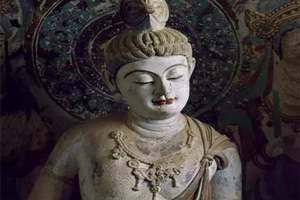
There are more than 200 music-themed caves in the Dunhuang murals, depicting many bands, musicians and musical instruments. According to statistics, there are more than 500 groups of different types of bands and more than 4,500 musical instruments of various types. There are also other music materials in Dunhuang Buddhist scriptures. The rich music image data shows the continuous development and change of Chinese music culture for nearly a thousand years. It has provided precious materials for Chinese and Western music exchanges.
There are dancing images in the murals of Mogao Grottoes. The dance and music scenes that reflect the social life, and customs of the world, such as Western music and dance, folk banquets, and wedding dance music. And many dance and music scores and related materials preserved in the Buddhist scripture cave. The art of dancing is an art of time and space that cannot be preserved. The image of ancient dancing is rarely known to modern people. As far as the collection of dancing images of the Mogao Grottoes is concerned, it can be called a museum of dancing art, which has preserved countless superb dancing skills and perfect dancing art. The image represents the appearance and development of dance in various eras.
The Mogao Grottoes, Longmen Grottoes in Luoyang, Henan Province, and Yungang Grottoes in Datong, Shanxi Province, are called the three largest grottoes in China. Then, the three Grottoes and Maijishan Grottoes are called the four largest grottoes in China.
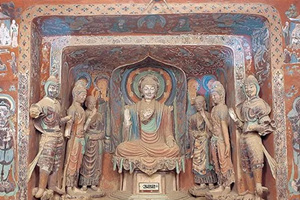
Mogao Grottoes was built in the period of the Sixteen Kingdoms of ancient China. According to the book named Li Kerang Rebuilt the Buddhas’ Niche Stele of Mogao Grottoes. In the Tang Dynasty and the second year of Jianyuan of the Qin Dynasty (366 AD), the monk Lezun passed this mountain and suddenly saw golden light. It seemed that there were thousands of Buddhas, and then he dug the first cave in the rock wall. Since then, the monk Faliang and others continued to build caves and practice meditation here. Later generations named it as Mogao Grottoes.
During the Northern Wei, Western Wei and Northern Zhou Dynasties, the rulers believed in Buddhism, and the construction of grottoes was supported by nobles so it developed rapidly.
During the Sui and Tang Dynasties, with the prosperity of the Silk Road, Mogao Grottoes prospered. After the An Shi Rebellion, Dunhuang was successively occupied by Tubo and Guiyi troops, but the construction of sculpture was not affected much. During the Northern Song, Xixia and Yuan dynasties, Mogao Grottoes gradually declined. Only the former dynasty caves were rebuilt, with very few newly built caves.
After the Yuan Dynasty, Dunhuang stopped building caves and gradually fell into disuse. In the 7th year of Jiajing in the Ming Dynasty (1528), Jiayu Pass was closed, making Dunhuang a nomadic place in the frontier fortress.

In the twenty-sixth year of Guangxu in Qing Dynasty (1900), the Tibetan scripture cave that shocked the world was discovered. Unfortunately, under the Western powers’ aggression against China, shortly after the discovery of the Tibetan scripture cave cultural relics, western explorers came to Dunhuang one after another. They defrauded a large number of Buddhist cultural relics from Taoist by unfair means, causing the Buddhist scriptural cave cultural relics to be looted tragically, and most of them were scattered in Britain, France, Russia, and Russia. Only a few are kept in China, causing an unprecedented catastrophe in the history of Chinese culture.
In 1961, Mogao Grottoes was announced by the State Council of the People's Republic of China as one of the first batch of national key cultural relics protection units.
In 1987, Mogao Grottoes was listed as one World Cultural Heritage.
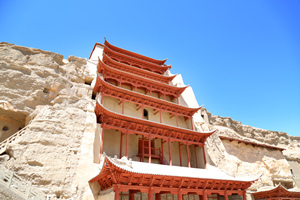
This is No. 96 Cave, which was excavated in the early Tang Dynasty. The big Buddha in the cave is 35.5 meters high and the width between the knees is 12 meters. It is the largest Buddha in Mogao Grottoes.
According to the ancient book called Mogao Grottoes, this giant Buddha was built by Chan Master Lingyin and Lay Buddhist Yinzu in the Tang Dynasty. It is Maitreya Buddha, the "future Buddha" of the three generations of the Buddha Kingdom, which is the successor of Sakyamuni. The big Buddha is made of stone-shaped clay sculpture, which is to cut out from the rocky sandstone body of the cliff, and then molded it with grass mud and hemp mud, and finally colored it. This big Buddha has been rebuilt many times, so it is no longer what it was in the Tang Dynasty, but it’s still majestic.
The construction in front of the cave is called Nine-Storey building because it has nine floors. It was originally four-storey and it was built in the late Tang Dynasty (874~879) with five floors and then it was rebuilt in the early Song Dynasty (966). The Nine-Storey Building was built in 1935, which has become one of the symbols of Mogao Grottoes.
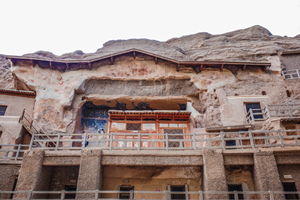
The Three-Storey Bulding is No.16-17 caves. No.16 cave was built between the fifth year of Dazhong and Xiantong in the Tang Dynasty(851-867). A three-storey wooden cave eaves were built on the cliff in front of the cave, so it is commonly known as the Three-Storey Building. It was built by the Taoist in the 32nd year of Guangxu in the Qing Dynasty (1906). The Taoist discovered the Tibetan scripture cave on the north side of the corridor of Cave 16, which was later numbered as Cave 17. Therefore, the three-storey building is also one of the few caves within a cave. Among them, the Seventeenth Cave (Late Tang, 848~906), also known as the Tibetan Scripture Cave, is located on the north wall of the 16th cave.
In the early eleventh century, due to wars and other reasons, a large number of Buddhist scriptures, Buddhist paintings, ritual instruments, and other religious and social documents were hidden here. The doors were closed and decorated with murals. As time went by, the closure of the door was gradually forgotten by people.
In 1900 (May 26th, 26th year of Guangxu, Qing Dynasty), this secret room was accidentally discovered by Taoist Wang Yuanlu while cleaning up the sand. But the sad thing is that from 1905 to 1915, the English named Stein, the French named Percy, Japanese named Ki Ruichao, Yoshikawa Koichiro and the Russian named Odenburg defrauded nearly 40,000 pieces of ancient documents from Wang Yuanlu at a low price.
The preserved ancient books in Dunhuang are all-encompassing and cover various fields including politics, economy, military affairs, literature, history, geography, medicine, science, technology, ethnicity, religion, and art of ancient China from the fourth to the eleventh century.

In 1900, Taoist Wang Yuanlu, who lived in Mogao Grottoes, carried out a large-scale cleaning in order to convert part of the caves that had been abandoned for a long time into Taoist temples. When he was clearing the silt for Cave 16, he stumbled upon a small door on the wall of the corridor on the north side. After opening it, a square cave room with a length of 2.6 meters and a height of 3 meters appeared, which contains more than 50,000 documents, paintings, silk paintings, embroidery and other cultural relics from the 4th century to the 11th century. This is the famous Scripture-storing Cave.
The inner wall of the Scripture-storing Cave is painted with images of bodhi trees and bhikshuni. Judging from the documents unearthed in the cave, the latest one was written during the Northern Song Dynasty. Therefore, it can be inferred that the Scripture-storing Cave was closed in the 11th century AD after the monks in Mogao escaped the Xixia army.
The Scripture-storing Cave of Mogao Grottoes is a very important discovery in the history of Chinese archaeology. Most of the unearthed documents are manuscripts, and a few are in engraved copies. About five-sixths of them are written in Chinese. The contents of the documents are mainly Buddhist scriptures. In addition to Taoism, Confucian classics, novels, poems, historical records, cadastres, account books, calendars, many of them are the only existing copy preserved. They have important historical materials and scientific value for the study of the history of China and Central Asia.
Exhibition Hall of Scripture-storing Cave was reconstructed from the lower temple of the original Mogao Grottoes. It displays cultural relics related to the Scripture-storing Cave, including copies of preserved ancient books of Dunhuang and paintings which were lost abroad, as well as the discovery of the Scripture-storing Cave and a historical review of the looting. It also has an introduction to the nowadays development of Dunhuang Studies.
Chinese: 请带我去莫高窟。English: Please take me to the Mogao Grottoes.
If you go to the Mogao Grottoes from the center of Dunhuang, it takes about 30 minutes(25 yuan).
If you go to the Mogao Grottoes from the Dunhuang Mogao International airport, it takes about 25 minutes(20 yuan).
If you go to the Mogao Grottoes from the Dunhuang Railway Station, it takes about 20 minutes(17 yuan).
